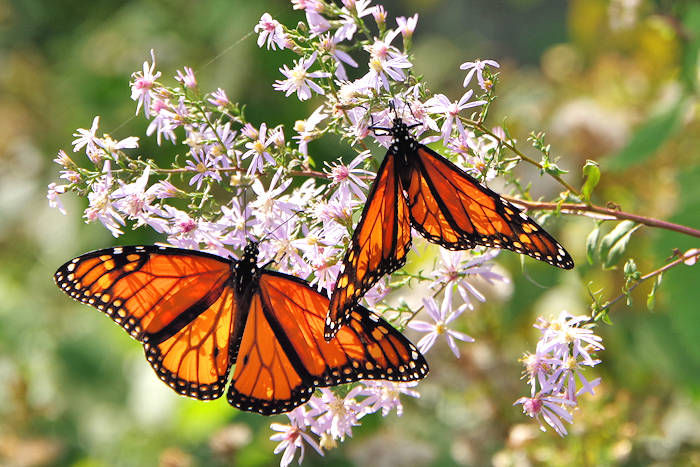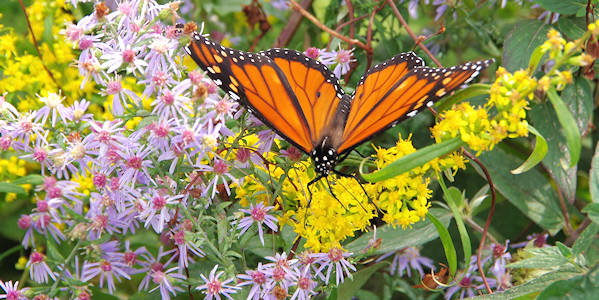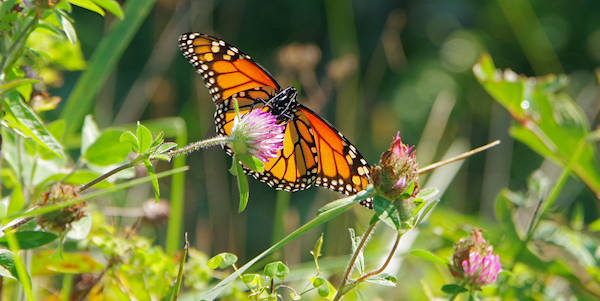
The amazing Monarch Butterfly migrates 2,000+ miles each fall from the Northeast United States to Mexico, passing through the Asheville area in September and early October. They usually travel at treetop level along mountain ridges, so they are usually harder to see in lower elevations. But you can watch them on their journey as they pass through the high passes along the Blue Ridge Parkway. We took the photo above and below at Milepost 413.2 Pounding Mill Parking Overlook on September 29th. There are many wildflowers there to keep the dozens of monarchs busy.

Their wings feature an easily recognizable black, orange, and white pattern. It's the only butterfly in North America to fly south in the fall and do a return migration in the spring. The Monarchs that winter in Mexico start their journey back in the spring but die on the way. So their descendants finish the trip to northern breeding grounds where they lay their eggs on young milkweed plants.
The Monarchs that fly through the Asheville area probably came from eggs that were laid in milkweed meadows in Pennsylvania, New York, Ohio and Canada. They start their migration in mid-August and travel about seven miles per hour.
Blue Ridge Parkway
While they can been seen in many high elevation areas, some favorite spots to watch on the Blue Ridge Parkway include
- Milepost 412.2, Wagon Road Gap, elevation 4,550 feet
- Milepost 413.2 Pounding Mill Parking Overlook, elevation 4,700 (Top choice!)
- Milepost 415.7, Cherry Cove Overlook (interpretive sign there) Elevation 4,327
- Milepost 425.3: Doubletop Mountain Overlook, Elevation 5,365

Orchard at Altapass
Learn all about the monarch with indoor terrariums and take a hayride through the orchard for staff members to help you spot the monarchs. While their butterfly garden is a popular spot, we found more monarchs enjoying the wildflowers in the apple orchard. Read more about the Orchard at Altapass.
Fascinating Facts
- The best viewing time is after a cold front has moved through and the wind is blowing from the north.
- About 20 years ago, an estimated one billion monarchs made this migration. In 2015, only 150 million monarchs made the trek. This dramatic decrease is due to the butterflies’ loss of habitat and food sources, including the milkweed plant.
- Unlike some species of butterflies, Monarchs have only one larval plant, so they depend on milkweed for survival. Unfortunately, the milkweed plant is frequently mowed down when housing or commercial development projects are begun.
- Female monarchs lay their eggs on the underside of poisonous milkweed leaves. As the caterpillar hatches, it eats its own egg and enjoys a diet of milkweed leaves. The milkweeds’ toxins remain permanently in the monarch’s system, even after the caterpillar metamorphoses into a butterfly. Animals that eat a monarch become very sick and, thereafter, will avoid them!
- Most monarchs will live only a few weeks, but the generation that emerges in late summer and early fall is different. These butterflies are born to travel and may live for eight or nine months to accomplish their lengthy migration.

Life of the Monarch sculpture at the NC Arboretum
Watch our Video of Monarchs along the Blue Ridge Parkway

